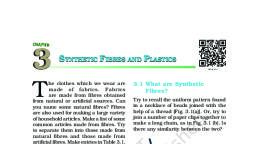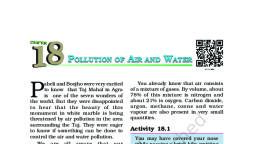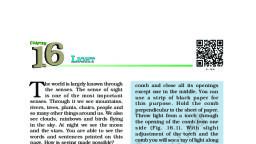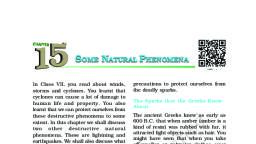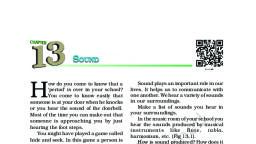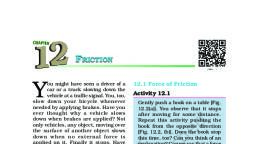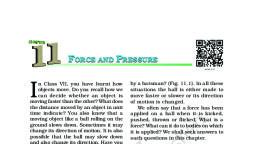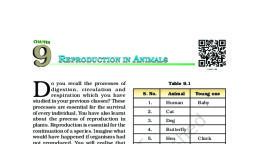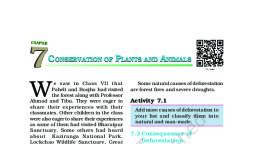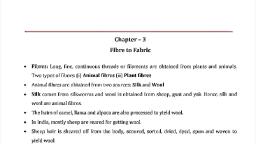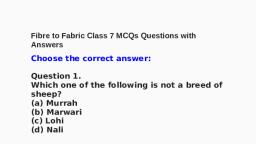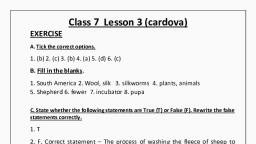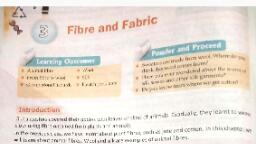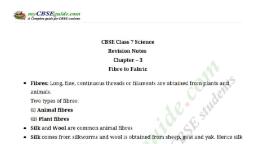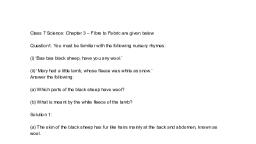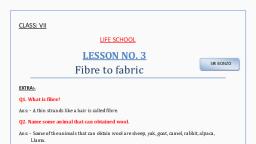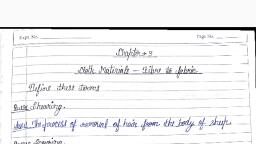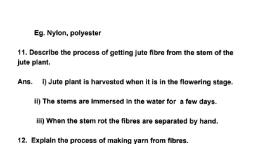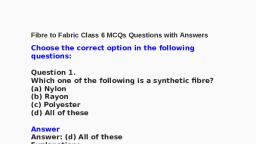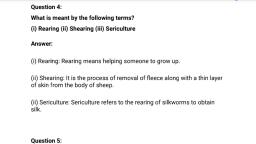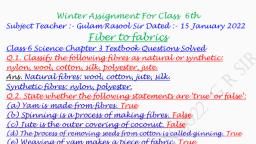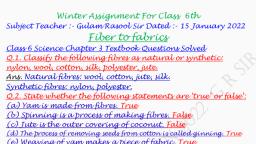Page 1 :
3, , Fibre to Fabric, , I, , n Class VI you have learnt about, some fibres obtained from plants., You also learnt that wool and silk, fibres are obtained from animals. Wool, is obtained from the fleece (hair) of, sheep or yak. Silk fibres come from, cocoons of the silk moth. Do you know, which part of the sheep’s body yields, fibres? Are you aware how these fibres, are converted into the woollen yarn that, we buy from the market to knit sweaters?, Do you have any idea how silk fibres are, made into silk, which is woven into saris?, In this Chapter we shall try to find, answers to these questions., , Like us, the hairy skin of the sheep, has two types of fibres that form its, fleece: (i) the coarse beard hair, and, (ii) the fine soft under-hair close to the, skin. The fine hair provide the fibres for, making wool. Some breeds of sheep, possess only fine under -hair. Their, parents are specially chosen to give birth, to sheep which have only soft underhair. This process of selecting parents, for obtaining special characters in their, offspring, such as soft under hair in, sheep, is termed ‘selective breeding’., , Animal fibres — wool and silk, 3.1 WOOL, Wool comes from sheep, goat, yak and, some other animals. These wool-yielding, animals bear hair on their body. Do you, know why these animals have a thick, coat of hair? Hair trap a lot of air. Air is, a poor conductor of heat, as you would, learn in Chapter 4. So, hair keeps these, animals warm. Wool is derived from, these hairy fibres., , Activity 3.1, Feel the hair on your body and arms, and those on your head. Do you find, any difference? Which one seems coarse, and which one is soft?, , Fig. 3.1 Sheep with thick growth of hair, , Animals that yield wool, Several breeds of sheep are found in, different parts of our country (Table 3.1)., However, the fleece of sheep is not the, only source of wool, though wool, commonly available in the market is, , 24, , SCIENCE, , 2020-21
Page 2 :
sheep wool (Fig. 3.1). Yak (Fig. 3.2) wool, is common in Tibet and Ladakh. Mohair, is obtained from angora goats, (Fig. 3.3), found in hilly regions such as Jammu, and Kashmir., Wool is also obtained from goat hair, (Fig. 3.4). The under fur of Kashmiri, goat is soft. It is woven into fine shawls, called Pashmina shawls., The fur (hair) on the body of camels, is also used as wool (Fig. 3.5). Llama, and Alpaca, found in South America,, also yield wool (Fig. 3.6 and 3.7)., , Activity 3.3, Procure outline maps of India and the, world. Find out and mark the places on, the map where you find animals that, provide wool. Use different colours to, denote the location for different wool, yielding animals., , Activity 3.2, Collect pictures of animals whose hair, is used as wool. Stick them in your scrap, book. If you are unable to get pictures,, try and draw them from the ones given, in this book., Find out words for sheep, goat, camel, and yak in your local language and also, in other languages of our country., , Fig. 3.3 Angora goat, , Fig. 3.4 Goat, , Fig. 3.5 Camel, , Fig. 3.2 Yak, , Fig. 3.7 Alpaca, , Fig. 3.6 Llama, FIBRE TO FABRIC, , 25, , 2020-21
Page 3 :
From fibres to wool, For obtaining wool, sheep are reared., Their hair is cut and processed into, wool. Let us learn about this process., Rearing and breeding of sheep: If you, travel to the hills in Jammu & Kashmir,, Himachal Pradesh, Uttaranchal,, Arunachal Pradesh and Sikkim, or the, plains of Haryana, Punjab, Rajasthan, and Gujarat, you can see shepherds, taking their herds of sheep for grazing., Sheep are herbivores and prefer grass, and leaves. Apart from grazing sheep,, rearers also feed them on a mixture of, pulses, corn, jowar, oil cakes (material, left after taking out oil from seeds) and, minerals. In winter, sheep are kept, indoors and fed on leaves, grain and dry, fodder., Sheep are reared in many parts of, our country for wool. Table 3.1 gives the, names of some breeds of sheep reared, in our country for producing wool. The, quality and texture of the fibres obtained, from them is also indicated in the table., Certain breeds of sheep have thick, coat of hair on their body which yields, good quality wool in large quantities. As, , mentioned earlier, these sheep are, “selectively bred” with one parent being, a sheep of good breed., Once the reared sheep have, developed a thick growth of hair, hair is, shaved off for getting wool., , Processing fibres into wool, The wool which is used for knitting, sweaters or for weaving shawls is the, finished product of a long process,, which involves the following steps:, Step I: The fleece of the sheep along with a, thin layer of skin is removed from its, body [Fig. 3.8 (a)]. This process is called, shearing. Machines similar to those used, by barbers are used to shave off hair., Usually, hair are removed during the hot, weather. This enables sheep to survive, without their protective coat of hair. The, hair provide woollen fibres. Woollen, fibres are then processed to obtain, woollen yarn. Shearing does not hurt, the sheep just as it does not hurt when, you get a hair cut or your father shaves his, beard. Do you know why? The uppermost, layer of the skin is dead. Also, the hair of, sheep grow again just as your hair does., , Table 3.1 Some Indian breeds of sheep, S.No. Name of breed, , Quality of wool, , State where found, , 1., , Lohi, , Good quality wool, , Rajasthan, Punjab, , 2., 3., 4., 5., 6., , Rampur bushair, Nali, Bakharwal, Marwari, Patanwadi, , Brown fleece, Carpet wool, For woollen shawls, Coarse wool, For hosiery, , Uttar Pradesh,Himachal Pradesh, Rajasthan, Haryana, Punjab, Jammu and Kashmir, Gujarat, Gujarat, , 26, , SCIENCE, , 2020-21
Page 4 :
Step II: The sheared skin with hair is, thoroughly washed in tanks to remove, grease, dust and dirt. This is called, scouring. Nowadays scouring is done, by machines [Fig. 3.8 (b) and (c)]., Step III: After scouring, sorting is done., The hairy skin is sent to a factory where, hair of different textures are separated, or sorted., Step IV: The small fluffy fibres, called, burrs, are picked out from the hair., These are the same burrs which, , sometimes appear on your sweaters. The, fibres are scoured again and dried. This, is the wool ready to be drawn into fibres., Step V: The fibres can be dyed in various, colours, as the natural fleece of sheep, and goats is black, brown or white., Step VI: The fibres are straightened,, combed and rolled into yarn, [Fig. 3.8 (d)]. The longer fibres are, made into wool for sweaters and the, shorter fibres are spun and woven, into woollen cloth., , Fig. 3.8 (a) Shearing a sheep, Fig. 3.8 (b) Scouring in tanks, , Fig. 3.8 (d) Rolling into yarn, , Fig. 3.8 (c) Scouring by machines, , The processing of fibre into wool can be represented as follows:, Shearing → Scouring → Sorting → Cleaning of burrs, Rolling, , ↓, ← Dyeing, , FIBRE TO FABRIC, , 27, , 2020-21
Page 5 :
your mother/aunt/grandmother the, kind of silk saris they have. List the, kinds of silk., Before we discuss the process of, obtaining silk, it is necessary to know the, interesting life history of the silk moth., , Occupational hazard, Wool industry is an important, means of livelihood for many people, in our country. But sorter’s job is, risky as sometimes they get infected, by a bacterium, anthrax, which, causes a fatal blood disease called, sorter’s disease. Such risks faced by, workers in any industry are called, occupational hazards., , Life history of silk moth, The female silk moth lays eggs, from, which hatch larvae which are called, caterpillars or silkworms. They grow in, size and when the caterpillar is ready to, enter the next stage of its life history, called pupa, it first weaves a net to hold, itself. Then it swings its head from side, to side in the form of the figure of eight (8)., During these movements of the head,, the caterpillar secretes fibre made of a, , Boojho is wondering why it, hurts when someone pulls his, hair but not when he goes for a, haircut., , Boojho is wondering why a, cotton garment cannot keep us, as warm in winter as a woollen, sweater does., , (a) Male, , (b) Female, Adult silk moths, , Activity 3.4, Debate amongst your classmates, whether it is fair on the part of humans, to rear sheep and then chop off their, hair for getting wool., , (c) Eggs on mulberry leaves, , (d) Silkworm, , 3.2 SILK, Silk fibres are also animal fibres., Silkworms spin the ‘silk fibres’. The, rearing of silkworms for obtaining silk, is called sericulture. Find out from, 28, , (e) Cocoon, , (f) Cocoon with developing moth, , Fig. 3.9 (a to f ) Life history of silk moth, SCIENCE, , 2020-21
Page 6 :
protein which hardens on exposure to, air and becomes silk fibre. Soon the, caterpillar completely covers itself by, silk fibres and turns into pupa. This, covering is known as cocoon. The further, development of the pupa into moth, continues inside the cocoon (Fig. 3.9). Silk, fibres are used for weaving silk cloth. Can, you imagine that the soft silk yarn is as, strong as a comparable thread of steel!, The silk yarn (thread) is obtained, from the cocoon of the silk moth. There, is a variety of silk moths which look very, different from one another and the silk, yarn they yield is different in texture, (coarse, smooth, shiny, etc.). Thus,, tassar silk, mooga silk, kosa silk, etc.,, are obtained from cocoons spun by, different types of moths. The most, common silk moth is the mulberry silk, moth. The silk fibre from the cocoon of, this moth is soft, lustrous and elastic, and can be dyed in beautiful colours., Sericulture or culture of silkworms, is a very old occupation in India. India, produces plenty of silk on a commercial, scale., , Activity 3.5, Collect pieces of silk cloth of various, types and paste them in your scrap, book. You can find them in a tailor’s, shop among the heap of waste cut pieces., , Take help of your mother, aunt or, teacher and identify the types of silk, such as mulberry silk, tassar silk, eri, silk, mooga silk, etc. Compare the, texture of these silks with that of the, artificial silk pieces, which contain, synthetic fibres. Try and collect pictures, of different moths whose caterpillars, provide the various types of silk., , Activity 3.6, Take an artificial (synthetic) silk thread, and a pure silk thread. Burn these, threads carefully. Did you notice any, difference in the smell while burning?, Now, burn a woollen fibre carefully., Did it smell like burning of artificial, silk or that of pure silk? Can you, explain why?, To remember when the cocoon stage, is reached in the life history of the silk, moth, try the following activity., , Activity 3.7, Photocopy Fig. 3.9. Cut out pictures of, the stages of the life history of the silk, moth, and paste them on pieces of, cardboard or chart paper. Jumble, them. Now try and arrange the stages, in the correct sequence in a cyclic form., Whoever does it fastest wins., You may also describe the life history, in your own words. Write it down in your, scrap book., , In India, women are significantly involved in various kinds of industries related, to silk production. These are rearing of silkworms, reeling of silk from cocoons, and processing of raw silk into fabrics. By their enterprise, they contribute to, the nation’s economy. China leads the world in silk production. India also ranks, among the leading silk producing countries., FIBRE TO FABRIC, , 29, , 2020-21
Page 7 :
From cocoon to silk, For obtaining silk, moths are reared, and their cocoons are collected to get, silk threads., Rearing silkworms: A female silk moth, lays hundreds of eggs at a time, [Fig. 3.10 (a)]. The eggs are stored, carefully on strips of cloth or paper and, sold to silkworm farmers. The farmers, , keep eggs under hygienic conditions, and under suitable conditions of, temperature and humidity., The eggs are warmed to a suitable, temperature for the larvae to hatch from, eggs. This is done when mulberry trees, [Fig. 3.10 (b)] bear a fresh crop of leaves., The larvae, called caterpillars or, silkworms, eat day and night and, increase enormously in size [Fig. 3.10 (c)]., , Leaf of Mulberry, (a) Female silkworm, moth with eggs, , (b) Mulberry tree, , (c) Larva (Caterpillar/, Silkworm) feeding on, mulberry leaves, , (d) Cocoons, Fig. 3.10 Rearing silkworms, , Discovery of silk, The exact time of discovery of silk is perhaps unknown. According to an old, Chinese legend, the empress Si-lung-Chi was asked by the emperor Huang-ti to, find the cause of the damaged leaves of mulberry trees growing in their garden., The empress found white worms eating up mulberry leaves. She also noticed, that they were spinning shiny cocoons around them. Accidentally a cocoon, dropped into her cup of tea and a tangle of delicate threads separated from the, cocoon. Silk industry began in China and was kept a closely guarded secret for, hundreds of years. Later on, traders and travellers introduced silk to other, countries. The route they travelled is still called the ‘silk route’., 30, , SCIENCE, , 2020-21
Page 8 :
The larvae are kept in clean bamboo, trays along with freshly chopped, mulberry leaves. After 25 to 30 days,, the caterpillars stop eating and, move to a tiny chamber of bamboo in, the tray to spin cocoons [Fig. 3.10 (d)]., Small racks or twigs may be provided, in the trays to which cocoons get, attached. The caterpillar or silkworm, spins the cocoon inside which develops, the silk moth., Processing silk: A pile of cocoons is, used for obtaining silk fibres. The, cocoons are kept under the sun or boiled, or exposed to steam. The silk fibres, , Paheli wants to know if the, cotton thread and silk thread, are spun and woven in the, same manner., separate out. The process of taking out, threads from the cocoon for use as silk, is called reeling the silk. Reeling is done, in special machines, which unwind, the threads or fibres of silk from the, cocoon. Silk fibres are then spun into, silk threads, which are woven into silk, cloth by weavers., , Keywords, Cocoon, , Scouring, , Silk moth, , Fleece, , Sericulture, , Silkworm, , Reeling, , Shearing, , Sorting, , What you have learnt, n, , Silk comes from silkworms and wool is obtained from sheep, goat and, yak. Hence silk and wool are animal fibres., , n, , The hairs of camel, llama and alpaca are also processed to yield wool., , n, , In India, mostly sheep are reared for getting wool., , n, , Sheep hair is sheared off from the body, scoured, sorted, dried, dyed,, spun and woven to yield wool., , n, , Silkworms are caterpillars of silk moth., , n, , During their life cycle, the worms spin cocoons of silk fibres., , n, , Silk fibres are made of a protein., , n, , Silk fibres from cocoons are separated out and reeled into silk threads., , n, , Weavers weave silk threads into silk cloth., , FIBRE TO FABRIC, , 31, , 2020-21
Page 9 :
Exercises, 1., , You must be familiar with the following nursery rhymes:, (i) ‘Baa baa black sheep, have you any wool.’, (ii) ‘Mary had a little lamb, whose fleece was white as snow.’, Answer the following:, (a) Which parts of the black sheep have wool?, (b) What is meant by the white fleece of the lamb?, , 2., , The silkworm is (a) a caterpillar, (b) a larva. Choose the correct option., (i) a, , 3., , (ii) b, , (iv) neither a nor b., , Which of the following does not yield wool?, (i) Yak, , 4., , (iii) both a and b, , (ii) Camel, , (iii) Goat, , (iv) Woolly dog, , What is meant by the following terms?, (i) Rearing (ii) Shearing (iii) Sericulture, , 5., , Given below is a sequence of steps in the processing of wool. Which are, the missing steps? Add them., Shearing, __________, sorting, __________,, , __________,, , _________., , 6., , Make sketches of the two stages in the life history of the silk moth which, are directly related to the production of silk., , 7., , Out of the following, which are the two terms related to silk production?, Sericulture, floriculture, moriculture, apiculture and silviculture., Hints: (i), (ii), , 8., , Silk production involves cultivation of mulberry leaves and, rearing silkworms., Scientific name of mulberry is Morus alba., , Match the words of Column I with those given in Column II:, Column I, , Column II, , 1., , Scouring, , (a), , Yields silk fibres, , 2., , Mulberry leaves, , (b), , Wool yielding animal, , 3., , Yak, , (c), , Food of silk worm, , 4., , Cocoon, , (d), , Reeling, , (e), , Cleaning sheared skin, , 32, , SCIENCE, , 2020-21
Page 10 :
9., , Given below is a crossword puzzle based on this lesson. Use hints to fill, in the blank spaces with letters that complete the words., , Down, , Across, , (D) 1 : Thorough washing, , (A) 1 : Keeps warm, , 2 : Animal fibre, 3 : Long thread like structure, , 2 : Its leaves are eaten by silkworms, 3 : Hatches from egg of moth, , Extended Learning — Activities and Projects, 1., , Paheli wants to know the, maximum length of, continuous silk thread that, can be obtained from a cocoon., Find out for her., 2., , Boojho wants to know why, caterpillars need to shed their skin, when they grow bigger but we, humans do not., Do you have any idea?, , FIBRE TO FABRIC, , 33, , 2020-21
Page 11 :
3., , Boojho wants to know why, caterpillars should not be collected, with bare hands., , Can you help him?, 4., , Paheli wanted to buy a silk frock and went to the market with her mother., There they found that the artificial (synthetic) silk was much cheaper, and wanted to know why. Do you know why? Find out., , 5., , Someone told Paheli that an animal called ‘Vicuna’ also gives wool. Can, you tell her where this animal is found? Look for this in a dictionary or, an encyclopaedia., , 6., , When handloom and textile exhibitions are held, certain stalls display, real moths of various varieties of silk and their life histories. Try and, visit these stalls with elders or teachers and see these moths and stages, of their life history., , 7., , Look for eggs of any moth or butterfly in your garden or park or any, other place full of plants. They look like tiny specks (dots) laid in a, cluster on the leaves. Pull out the leaves containing eggs and place, them in a cardboard box. Take some leaves of the same plant or another, plant of the same variety, chop them and put them in the box. Eggs will, hatch into caterpillars, which are busy eating day and night. Add leaves, everyday for them to feed upon. Sometimes you may be able to collect, the caterpillars. But be careful. Use a paper napkin or a paper to hold, a caterpillar., Observe everyday. Note the (i) number of days taken for eggs to hatch,, (ii) number of days taken to reach the cocoon stage, and (iii) number of, days to complete life cycle. Record your observations in your notebook., , Did you know?, In terms of the number of sheep, India ranks third in the world, behind, China and Australia. However, the New Zealand sheep are known to yield, the best wool., , 34, , SCIENCE, , 2020-21

